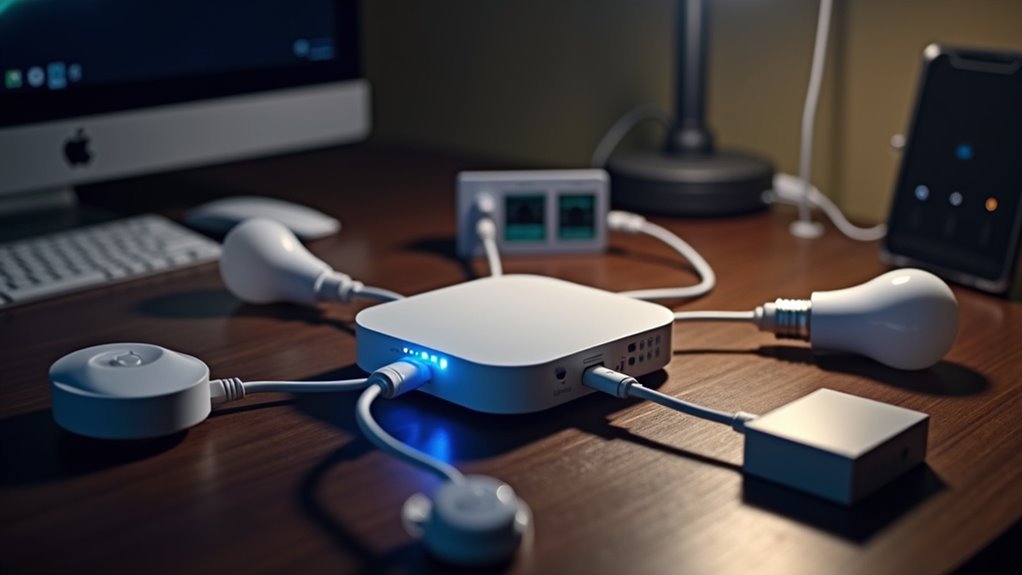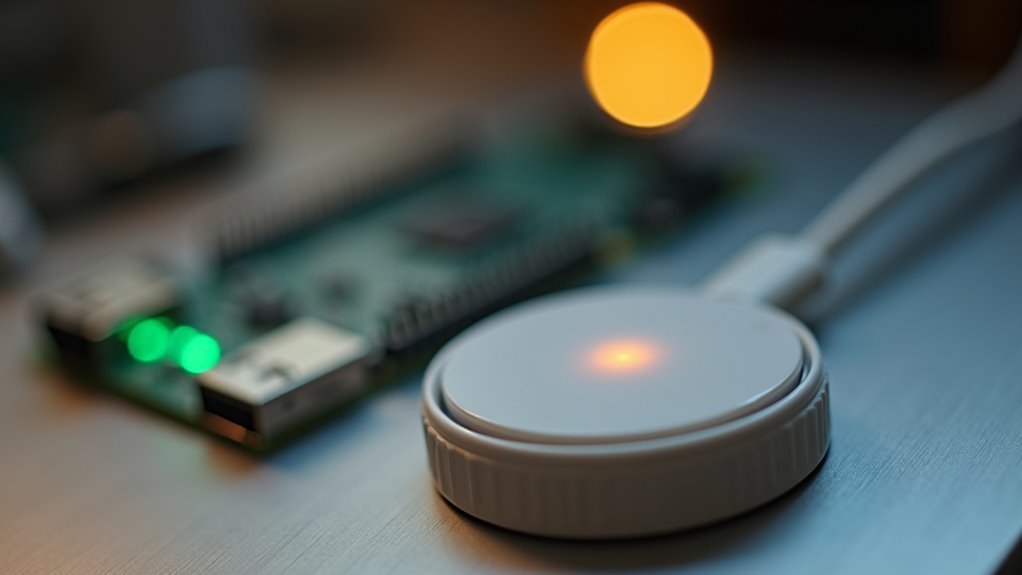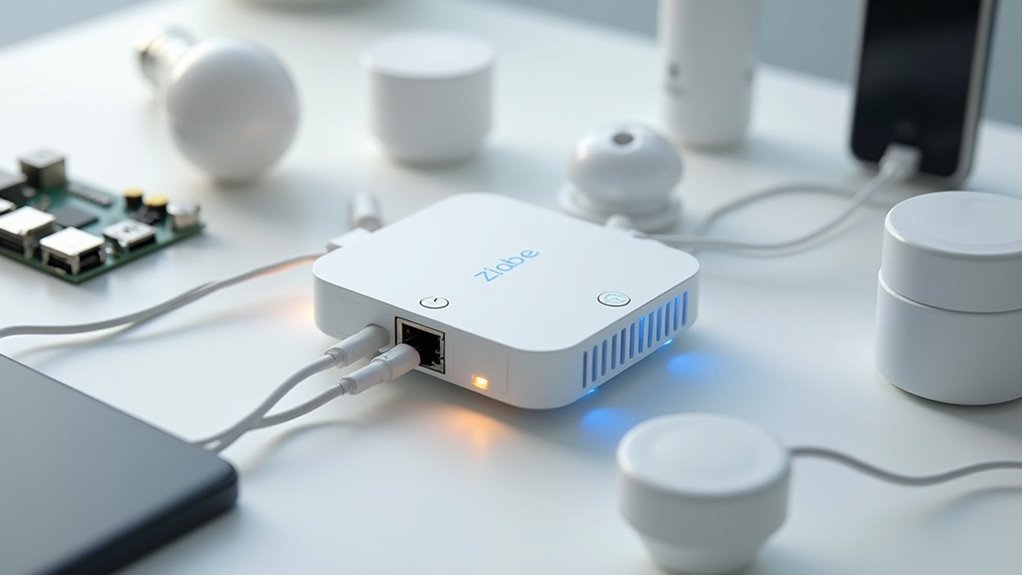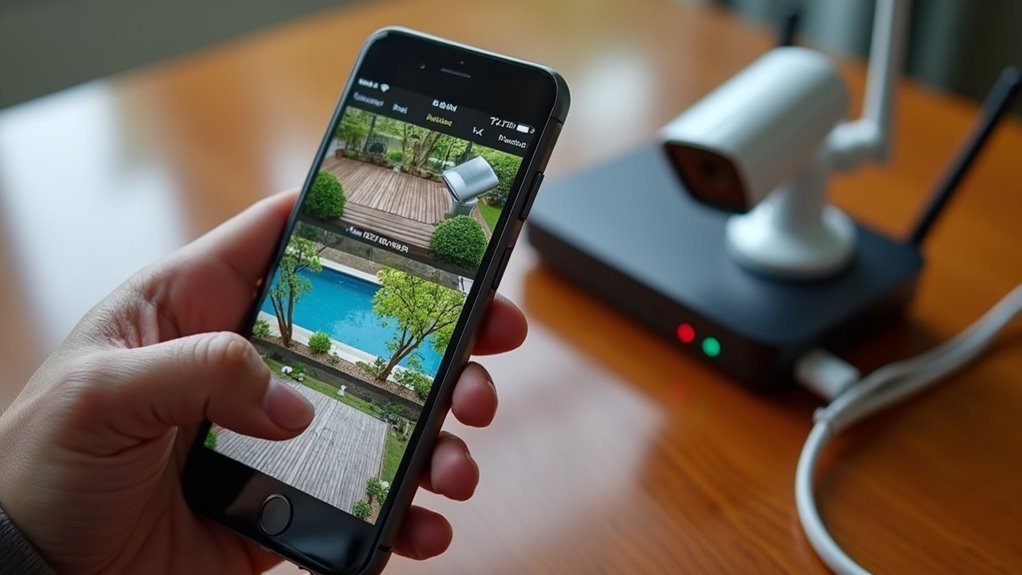You’ve probably heard about Zigbee2MQTT if you’re exploring smart home automation, but understanding how it integrates with Home Assistant can transform your entire setup. This powerful combination eliminates the need for multiple proprietary hubs while giving you direct control over your Zigbee devices through an open-source platform. However, the real magic happens when you discover what lies beneath the surface of this integration.
Understanding MQTT Discovery for Automatic Device Detection

When you enable MQTT discovery in Zigbee2MQTT, Home Assistant automatically detects and configures your Zigbee devices without requiring manual setup for each one.
This streamlined process eliminates the tedious task of manually adding device entries to your Home Assistant instance.
To activate this feature, you’ll need to add `homeassistant: enabled: true` to your Zigbee2MQTT configuration.yaml file and guarantee the MQTT integration is running in Home Assistant.
Once enabled, each connected device sends a discovery payload containing vital information like device type and unique identifiers.
The discovery payload follows a specific topic structure that prevents duplicate entries while providing your Home Assistant instance with everything needed for proper device integration.
You can also customize these payloads for enhanced control.
Setting Up Mosquitto Broker and MQTT Integration
You’ll need to install the Mosquitto Broker add-on from Home Assistant’s Add-on Store to create a reliable MQTT communication hub for your Zigbee devices.
Once installed, configure the MQTT connection by providing your broker’s hostname, port number, and authentication credentials if you’re using username and password protection.
This setup creates a secure, private messaging system that’ll handle all communication between Zigbee2MQTT and Home Assistant.
Installing Mosquitto Broker
Before diving into Zigbee2MQTT configuration, you’ll need a reliable MQTT broker to handle device communication between your smart devices and Home Assistant. The Mosquitto broker offers the ideal solution as an easy-to-install add-on within Home Assistant.
To install Mosquitto, navigate to your Home Assistant’s add-on store and search for “Mosquitto broker.” Click install and wait for completion. During configuration, you’ll set essential parameters including hostname, port, username, and password to establish proper MQTT integration.
For optimal security and compatibility, choose a private Mosquitto broker over public alternatives.
After installation, you can customize advanced settings like client IDs, TLS validation, and keep-alive intervals. Test your setup using command-line tools like `mosquitto_pub` to verify message sending and receiving functionality works correctly.
Configuring MQTT Connection
Once you’ve successfully installed the Mosquitto broker, establishing the MQTT connection requires configuring specific parameters within Home Assistant’s integration settings.
Navigate to Settings > Devices & Services to add the MQTT broker integration. You’ll need to enter your broker’s hostname, port, username, and password for successful communication. Home Assistant will use these credentials to connect with your MQTT broker and manage device configuration automatically.
It’s recommended to use a private MQTT broker rather than public options for enhanced security and compatibility.
You can adjust the keep alive setting from the default 60 seconds to a minimum of 15 seconds based on your device needs. Discovery options within the configuration file allow you to enable or disable automatic device discovery and configure Birth and Last Will messages for best integrations performance.
Installing and Configuring Zigbee2MQTT Add-on

The Zigbee2MQTT add-on serves as the bridge between your Zigbee devices and Home Assistant, transforming complex Zigbee protocols into simple MQTT messages.
Installing this add-on is straightforward—navigate to the Add-on store, search for Zigbee2MQTT, and click the install button.
After installation, you’ll need proper configuration for seamless operation:
- Enter your MQTT server details in the configuration settings to establish communication
- Specify the dongle port information so your Zigbee coordinator is recognized properly
- Enable `homeassistant: enabled: true` in the configuration for automatic device discovery
Once configured, you can pair your Zigbee devices through the web interface by entering pairing mode.
Monitor the add-on logs to troubleshoot any connectivity issues during setup.
Device Management Through Home Assistant Interface
Managing your Zigbee devices becomes effortless through Home Assistant’s intuitive interface once you’ve successfully paired them with Zigbee2MQTT. The 2021.11 update introduced enhanced device management features, including direct frontend links for easier access to specific settings. You can customize device names using input selects and text fields, while built-in scripts handle renaming and removal without requiring restarts.
| Feature | Function |
|---|---|
| Device Renaming | Input selects and text fields for custom names |
| Script Management | Rename/remove devices without restart |
| Force Removal | Boolean option for stubborn devices |
| Join Duration | Input number sets new device onboarding time |
The integrations between Home Assistant and your MQTT device create seamless control over Zigbee functionalities. You’ll find the configuration file automatically updates, maintaining ideal device management throughout your smart home ecosystem.
Handling Button Actions With MQTT Device Triggers

Button presses from your Zigbee devices require a different approach than standard device management in Home Assistant. MQTT device triggers are the recommended method for handling button actions in your Zigbee2MQTT integration, providing real-time response without polling overhead.
When you configure button actions through MQTT device triggers, you’ll benefit from:
- Automatic discovery – Home Assistant finds device triggers after you press buttons once, streamlining setup
- Future-proof compatibility – Your configuration stays current with upcoming Home Assistant updates and features
- Real-time responsiveness – Button presses trigger immediate actions without delays from polling mechanisms
While you can monitor state changes of event entities as an alternative, this experimental approach isn’t recommended.
Avoid legacy methods like action sensor monitoring, as they’re deprecated and unsuitable for long-term Zigbee2MQTT configurations.
Customizing Discovery Payloads for Specific Devices
When you need device-specific configurations beyond standard discovery settings, customizing discovery payloads gives you granular control over how individual Zigbee devices integrate with Home Assistant.
You can modify attributes like `friendly_name`, `device`, and `unique_id` to create personalized identification systems for your specific devices. This customization prevents unwanted devices from appearing in Home Assistant by utilizing device-specific configuration options.
You’ll also gain control over MQTT topics and payload structures, improving communication between your devices and Home Assistant.
The best part about customizing discovery payloads is that you can make these modifications without restarting Home Assistant, allowing seamless updates to your integration settings whenever needed.
Controlling Zigbee2MQTT Functions via Home Assistant
Beyond customizing individual device configurations, you can completely control Zigbee2MQTT’s core functions directly through Home Assistant’s interface.
This extensive device management capability transforms how you interact with your Zigbee network through the MQTT protocol.
You’ll access powerful controls including:
- Device joining controls – Set custom join durations and receive notifications when new devices successfully connect to your network
- Renaming and removal scripts – Create automated MQTT commands to rename devices or force removal of problematic ones from your network
- Real-time network updates – Configure automation triggers that automatically refresh your device list, keeping your Zigbee2MQTT integration current
These features provide user-friendly input selects and streamlined management processes, giving you complete administrative control over your Zigbee network without leaving Home Assistant.
Creating Zigbee Network Visualization Maps
You can create powerful visual representations of your Zigbee network through custom network cards that display your entire device topology at a glance.
These visualization maps show real-time device status information, making it easy to identify which devices are online, offline, or experiencing connectivity issues.
The custom cards reveal the hierarchical structure of your network, clearly distinguishing between coordinators, routers, and end devices while showing their interconnected relationships.
Custom Network Card
One of the most valuable tools for managing your Zigbee2MQTT network is the custom network card, which transforms abstract device connections into clear visual maps within Home Assistant.
This visualization tool displays all your Zigbee devices with real-time status updates, making network connectivity issues immediately apparent.
The custom network card offers several key advantages:
- Interactive troubleshooting – You can quickly identify weak connections or offline devices through visual indicators
- Community-driven development – GitHub integration allows you to contribute improvements and access community enhancements
- Intuitive navigation – User-friendly design makes understanding device relationships and network topology straightforward
You’ll find the synchronized data invaluable for optimizing device placement and maintaining network performance, as it reflects your current Zigbee network state in real-time.
Device Status Overview
When managing multiple Zigbee devices across your smart home, understanding each device’s operational status becomes critical for maintaining network reliability.
Zigbee2MQTT’s device status visualization provides detailed real-time insights into your connected devices within Home Assistant. The network map displays essential information including signal strength, battery levels, and connectivity status for each device.
You’ll quickly identify problematic devices experiencing communication issues or low battery levels that require attention. This visualization enhances troubleshooting by showing which devices might be causing network disruptions.
The device status overview helps you monitor your entire Zigbee ecosystem efficiently, ensuring peak performance across all connected smart home components while preventing potential connectivity issues before they impact your automation routines.
Pairing and Managing Zigbee Devices in the System
The seamless pairing and management of Zigbee devices forms the backbone of any successful Home Assistant integration with Zigbee2MQTT.
You’ll enter pairing mode through the web UI or execute MQTT commands to initiate device discovery. The system’s automatic device discovery feature guarantees your new devices integrate smoothly without manual intervention.
- Unique Identifiers: Each device maintains a distinct identifier, preventing duplicate entries when reconnecting to your network.
- Device Control: You can rename, remove, or configure devices using input selects and scripts for enhanced management.
- Advanced Automation: Create sophisticated triggers and scripts based on specific device actions or states.
The integration provides real-time updates when devices join or leave your network, while supporting thorough automation capabilities that transform your smart home experience.
Troubleshooting Common Integration Issues
Despite careful setup and device pairing, you’ll inevitably encounter integration challenges that can disrupt your smart home’s functionality.
Start troubleshooting by verifying your MQTT broker’s configuration and connectivity, as these issues frequently cause device discovery failures. Check your Zigbee2MQTT logs for error messages that reveal connection problems or configuration errors.
Ensure the `homeassistant` setting in your Zigbee2MQTT configuration.yaml file is enabled for proper Home Assistant integration.
Examine device unique identifiers carefully, removing any duplicate entries in your MQTT broker that might create conflicts.
When devices won’t appear in Home Assistant despite proper pairing, restart both Zigbee2MQTT and Home Assistant services.
This refresh often triggers the discovery process and resolves communication issues between the systems.
Frequently Asked Questions
How to Connect Zigbee2mqtt to Home Assistant?
Install Mosquitto MQTT broker, configure your Zigbee2MQTT with MQTT server details, enable Home Assistant discovery by adding `homeassistant: enabled: true` to configuration.yaml, restart both services, then verify devices appear.
What Does Zigbee2mqtt Do?
Zigbee2MQTT converts Zigbee device communications into MQTT messages, letting you control lights, sensors, and switches through any MQTT-compatible system. You’ll bypass vendor-specific hubs and gain universal device compatibility.
What Is the Difference Between Integration and Add on Home Assistant?
You’ll find integrations connect Home Assistant directly to external devices and services, while add-ons are supplementary applications that run alongside Home Assistant, providing additional functionalities like databases or message brokers.
Do I Need a Zigbee Hub With Home Assistant?
You don’t need a separate Zigbee hub with Home Assistant. You can use a compatible USB Zigbee coordinator dongle with Zigbee2MQTT integration to control Zigbee devices directly through Home Assistant.





Leave a Reply